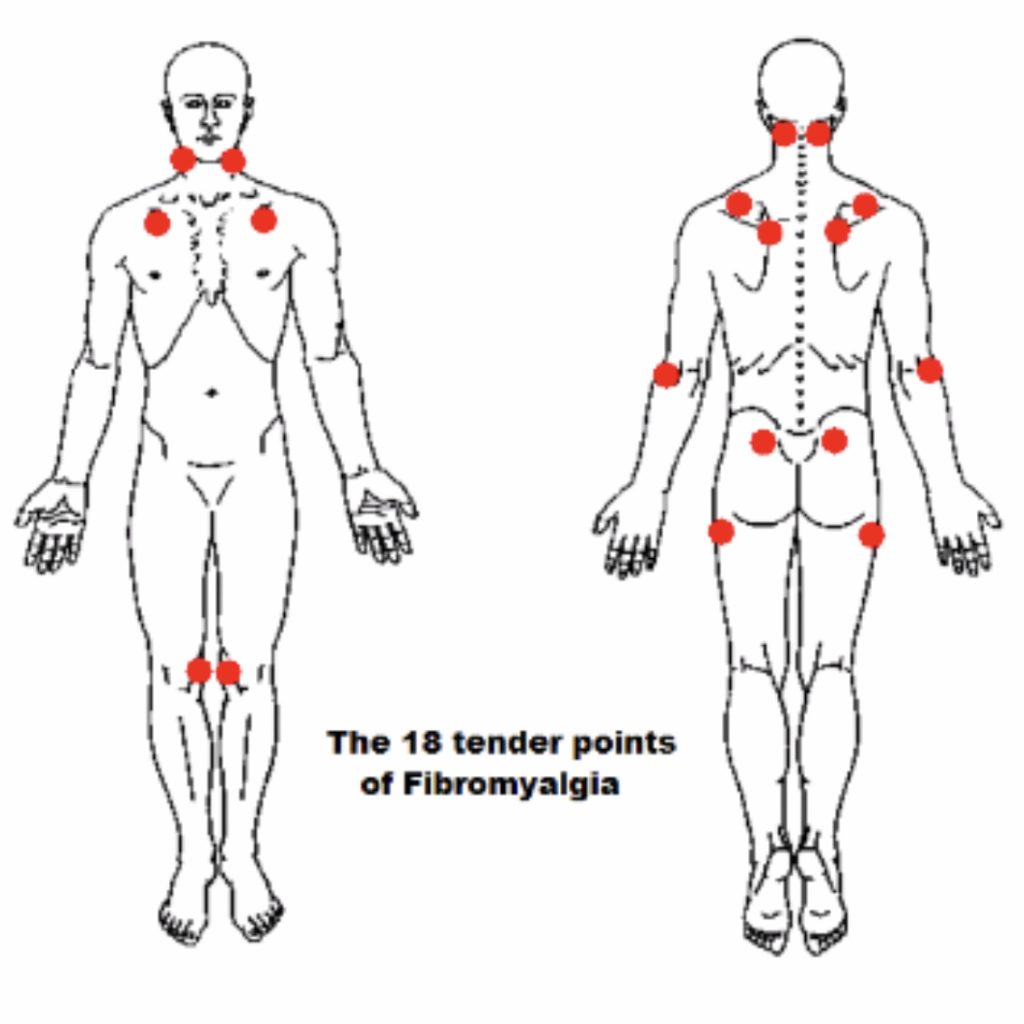What is Fibromyalgia?
Fibromyalgia is experienced as ‘widespread’ pain felt in muscles, tendons and ligaments over a period of 3 months or more, and can be accompanied with other symptoms such as; chronic fatigue, sleep disturbance, memory fog, irritable bowel syndrome (IBS), migraines, headaches, temporomandibular joint disorders, and painful bladder syndrome.
FACT: Fibromyalgia affects 2-4% of people, and usually affects women more often than men.
How is Fibromyalgia usually diagnosed?
Currently there is no cure or specific test to diagnose Fibromyalgia syndrome (FS). It is commonly diagnosed as a condition of exclusion, meaning that after all other conditions with similar symptoms, such as Lyme disease, multiple sclerosis, rheumatoid arthritis, lupus, hypothyroidism, polymyalgia rheumatica, and several others are ruled out, the diagnosis of fibromyalgia syndrome is given.
Do I have Fibromyalgia?
Diagnosis can be complicated and exhausting for the client.
The following indicators can help you to understand whether you might have Fibromyalgia, and if it is something that you should explore further with your doctor.
- You either have severe pain in 3 to 6 different areas of your body — Tender point map. These tender points are distributed all over the body, but mainly around the neck, shoulders and lower back. Tender points are one of the indicators for diagnosis, but not all patients experience them.
- Your symptoms have stayed at a similar level for at least 3 months
- No other reason for your symptoms has been found.

What does it feel like to have Fibromyalgia?
Fibromyalgia pain is felt in muscles and soft tissues.
An oversensitive Central Nervous System (CNS) interprets even harmless incoming stimuli as painful.
It is important to understand that everyone is different and so what one person experiences as uncomfortable or painful, another will find excruciating
Is it painful?
Central sensitization is when the central nervous system is in a persistent state of hypersensitivity to stimulus.
This leads to neutral (non painful) stimulus being perceived by the brain as a painful—for example the stroke of a feather feels like being speared by a blowtorch — this is called Allodynia
A second feature of Fybromyalgia is identified as Hyperalgesia of Central sensitization, which is when normal painful stimuli is interpreted (amplified) as much more painful. This means that pain is real and felt by the patient even in the absence of obvious injury or tissue damage.
What are the signs and symptoms?
The signs and symptoms vary from person to person, but can include the following:
- Sleep disorder
- Stiffness after rest (e.g. morning stiffness)
- Poor stamina
- Fatigue
- Memory problems, difficulty to remember things
- Widespread pain in shifting locations that is difficult to pin down.
- Tender points in Nine predictable pairs
- Digestive discomfort
What causes Fibromyalgia?
The exact cause is unknown, but there are a number of factors that can trigger Fibromyalgia:
- Changes in certain brain chemicals
- Heightened pain signals all over the body
- Genetics can play a small part
Physical or emotional events:
- An injury
- Giving birth
- A viral infection
- The breakdown of relationship
- Death of loved one
- Being in abusive relationship
Do you want to know if Clinical Massage can help?
Book Free online consultation now or give us a call to chat with us about your condition.
How can massage help manage symptoms for Fibromyalgia patients, and improve quality of life?
No definite evidence of muscle pathology in fibromyalgia has been found.
However, there is some evidence for dysfunction of the intramuscular connective tissue, or fascia, in fibromyalgia patients.
The study by (Liptan, G.L. 2010) proposes that inflammation of the fascia is the source of peripheral nociceptive input that leads to central sensitization in fibromyalgia.
Another study (Castro-Sánchez et al., 2011) demonstrated that massage-myofascial release therapy reduces the sensitivity to pain at tender points in patients with fibromyalgia, with massage leading to an improvement in their pain perception.
Research suggests that massage therapy can improve fibromyalgia symptoms.
While there are a number of massage types available to ease the symptoms of Fybromyalgia, a study (Liptan et al., 2013) comparing Swedish massage and myofascial release, indicated that myofascial release may result in greater reductions in Fibromyalgia symptoms compared to standard Swedish massage.
The JING Method is an Advanced Clinical Massage therapy that combines and applies a range of advanced techniques (including myofascial release and trigger point therapy) to achieve a specific outcome, whether that be a reduction in pain, increased range of movement, or improved quality of life.
This type of massage is tailored to you and your symptoms.
Selfcare tips to manage Fibromyalgia symptoms
The following tactics will help you to manage symptoms.
- Relaxation; mindfulness /meditation, breathing techniques
- movement /exercise aerobic and strength training
- Pacing yourself, it’s important balance yourself with periods of activity and relaxation
- Better sleeping habits
- Self-myofascial release
I successfully treat a number of clients who have been diagnosed with Fibromyalgia.
Whilst I can not offer a diagnosis, I am more than happy to offer advice and treatment that is proven to relieve pain.
For more advice on management of Fibromyalgia symptoms, get in touch and I will be happy to talk through your options.
Resources
- Werner, R. (2019). A Massage Therapist’s Guide to Pathology: Critical Thinking and Practical Application (7th ed.). Books of Discovery.
- nhs.uk. 2022. Fibromyalgia – Diagnosis. [online] Available at: <https://www.nhs.uk/conditions/fibromyalgia/diagnosis/>
- Woolf, Clifford J. Central sensitization: Implications for the diagnosis and treatment of pain, Pain: March 2011 – Volume 152 – Issue 3 – p S2-S15
- Liptan, G.L. (2010). Fascia: A missing link in our understanding of the pathology of fibromyalgia. Journal of Bodywork and Movement Therapies, 14(1), pp.3–12. doi:10.1016/j.jbmt.2009.08.003.
- Castro-Sánchez, A.M., Matarán-Peñarrocha, G.A., Granero-Molina, J., Aguilera-Manrique, G., Quesada-Rubio, J.M. and Moreno-Lorenzo, C. (2011). Benefits of Massage-Myofascial Release Therapy on Pain, Anxiety, Quality of Sleep, Depression, and Quality of Life in Patients with Fibromyalgia. Evidence-Based Complementary and Alternative Medicine, 2011, pp.1–9. doi:10.1155/2011/561753.
- Liptan G, Mist S, Wright C, Arzt A, Jones KD. A pilot study of myofascial release therapy compared to Swedish massage in fibromyalgia. J Bodyw Mov Ther. 2013 Jul;17(3):365-70. doi: 10.1016/j.jbmt.2012.11.010. Epub 2013 Jan 3. PMID: 23768283; PMCID: PMC5569886.







